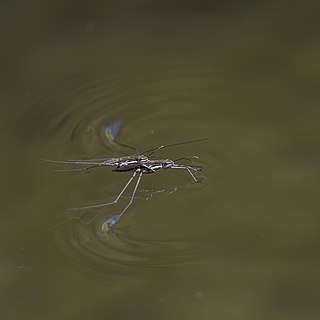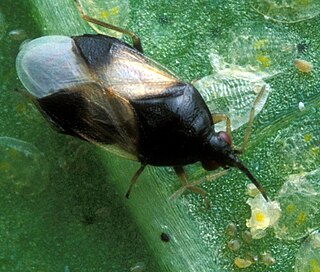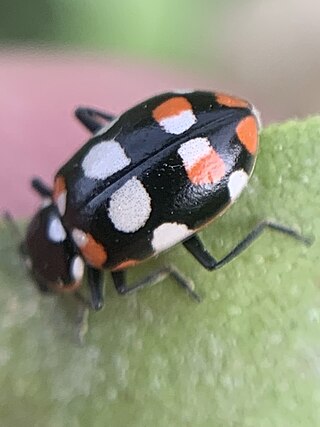
Helicoverpa zea, commonly known as the corn earworm, is a species in the family Noctuidae. The larva of the moth Helicoverpa zea is a major agricultural pest. Since it is polyphagous during the larval stage, the species has been given many different common names, including the cotton bollworm and the tomato fruitworm. It also consumes a wide variety of other crops.

Elasmucha grisea, common name parent bug, is a species of shield bugs or stink bugs belonging to the family Acanthosomatidae. The term parent bugs includes also the other species of the genus Elasmucha and some species of the family Acanthosomatidae.

The small heath is a butterfly species belonging to the family Nymphalidae, classified within the subfamily Satyrinae. It is the smallest butterfly in this subfamily. The small heath is diurnal and flies with a noticeable fluttering flight pattern near the ground. It rests with closed wings when not in flight. It is widespread in colonies throughout the grasslands of Eurasia and north-western Africa, preferring drier habitats than other Coenonympha, such as salt marshes, alpine meadows, wetlands, and grasslands near water. However, habitat loss caused by human activities has led to a decline in populations in some locations.

The Gerridae are a family of insects in the order Hemiptera, commonly known as water striders, water skeeters, water scooters, water bugs, pond skaters, water skippers, water gliders, water skimmers or puddle flies. Consistent with the classification of the Gerridae as true bugs, gerrids have mouthparts evolved for piercing and sucking, and distinguish themselves by having the unusual ability to walk on water, making them pleuston (surface-living) animals. They are anatomically built to transfer their weight to be able to run on top of the water's surface. As a result, one could likely find water striders present in any pond, river, or lake. Over 1,700 species of gerrids have been described, 10% of them being marine.

Polygonia c-album, or the “comma”, is a food generalist (polyphagous) butterfly species belonging to the family Nymphalidae. The angular notches on the edges of the forewings are characteristic of the genus Polygonia, which is why species in the genus are commonly referred to as anglewing butterflies. Comma butterflies can be identified by their prominent orange and dark brown/black dorsal wings.

Anthocoridae is a family of bugs, commonly called minute pirate bugs or flower bugs. Worldwide there are 500-600 species.

The genus Orius consists of omnivorous bugs in the family Anthocoridae. Adults are 2–5 mm long and feed mostly on smaller insects, larva and eggs, such as spider mites, thrips, jumping plant lice, and white fly, but will also feed on pollen and vascular sap.

The European corn borer, also known as the European corn worm or European high-flyer, is a moth of the family Crambidae. It is a pest of grain, particularly maize. The insect is native to Europe, originally infesting varieties of millet, including broom corn. The European corn borer was first reported in North America in 1917 in Massachusetts, but was probably introduced from Europe several years earlier. Since its initial discovery in the Americas, the insect has spread into Canada and westwards across the United States to the Rocky Mountains.

Traumatic insemination, also known as hypodermic insemination, is the mating practice in some species of invertebrates in which the male pierces the female's abdomen with his aedeagus and injects his sperm through the wound into her abdominal cavity (hemocoel). The sperm diffuses through the female's hemolymph, reaching the ovaries and resulting in fertilization.

Choristoneura fumiferana, the eastern spruce budworm, is a species of moth of the family Tortricidae native to the eastern United States and Canada. The caterpillars feed on the needles of spruce and fir trees. Eastern spruce budworm populations can experience significant oscillations, with large outbreaks sometimes resulting in wide scale tree mortality. The first recorded outbreaks of the spruce budworm in the United States occurred in about 1807, and since 1909 there have been waves of budworm outbreaks throughout the eastern United States and Canada. In Canada, the major outbreaks occurred in periods circa 1910–20, c. 1940–50, and c. 1970–80, each of which impacted millions of hectares of forest. Longer-term tree-ring studies suggest that spruce budworm outbreaks have been recurring approximately every three decades since the 16th century, and paleoecological studies suggest the spruce budworm has been breaking out in eastern North America for thousands of years.

Chorthippus brunneus, also known as the common field grasshopper, is a species of grasshopper of the subfamily Gomphocerinae. The species is common and widespread in the Western Palearctic, and the IUCN lists it as Least Concern.

Chloridea virescens, commonly known as the tobacco budworm, is a moth of the family Noctuidae found throughout the eastern and southwestern United States along with parts of Central America and South America.

Nezara viridula, commonly known as the southern green stink bug (USA), southern green shield bug (UK) or green vegetable bug, is a plant-feeding stink bug. Believed to have originated in Ethiopia, it can now be found across the world. Because of its preference for certain species of legumes, such as beans and soybeans, it is an economically important pest on such crops.

Orius insidiosus, common name the insidious flower bug, is a species of minute pirate bug, a predatory insect in the order Hemiptera. They are considered beneficial, as they feed on small pest arthropods and their eggs. They are mass-reared for use in the biological control of thrips.

Chrysomela populi is a species of broad-shouldered leaf beetle belonging to the family Chrysomelidae, subfamily Chrysomelinae.

Eriopis connexa is a species of ladybird beetle that is native to South America. Both males and females mate multiple times with different individuals of the opposite sex, like most members of the family Coccinellidae. This promiscuous behavior leads to unique reproductive adaptations, such as sperm mixing. Females lay unfertilized eggs which their offspring consume upon hatching, thereby boosting offspring nutrition and reducing sibling cannibalism,. This predatory beetle species feeds primarily on aphids and is widespread throughout many agroecosystems, such as cotton, maize, sorghum, soybean, and wheat. Due to aphids being extremely damaging agricultural pests, E. connexa has been introduced to the United States for biological pest management. Recent studies on pyrethroid insecticide resistance in E. connexa have led to research by applied entomologists on the species' potential role in integrated pest management schemes in crop fields that rely on lambda-cyhalothrin (LCT), a common pyrethroid insecticide that is ineffective against aphid population control. The potential efficacy and success of the utilization of E. connexa in these programs is widely debated and is the focus of much recent research due to the lack of understanding regarding the effects of pyrethroid resistance on the behavior of this species.

Ostrinia furnacalis is a species of moth in the family Crambidae, the grass moths. It was described by Achille Guenée in 1854 and is known by the common name Asian corn borer since this species is found in Asia and feeds mainly on corn crop. The moth is found from China to Australia, including in Java, Sulawesi, the Philippines, Borneo, New Guinea, the Solomon Islands, and Micronesia. The Asian corn borer is part of the species complex, Ostrinia, in which members are difficult to distinguish based on appearance. Other Ostrinia such as O. orientalis, O. scapulalis, O. zealis, and O. zaguliaevi can occur with O. furnacalis, and the taxa can be hard to tell apart.
Gerris buenoi is a species of water strider that belongs to the family Gerridae. It was first identified in 1911 and is native to continental USA and Canada. Individuals of this species are small in size and have modified appendages, allowing them to float and "skate" along the surface of the water. G. buenoi can be found near the shoreline of freshwater ponds and small lakes, where they hunt for terrestrial insects that have fallen into the water.

Lyctocoridae is a reconstituted family of bugs, formerly classified within the minute pirate bugs of the family Anthocoridae. It is widely distributed, with one species, being cosmopolitan.

Aedes taeniorhynchus, or the black salt marsh mosquito, is a mosquito in the family Culicidae. It is a carrier for encephalitic viruses including Venezuelan equine encephalitis and can transmit Dirofilaria immitis. It resides in the Americas and is known to bite mammals, reptiles, and birds. Like other mosquitoes, Ae. taeniorhynchus adults survive on a combination diet of blood and sugar, with females generally requiring a blood meal before laying eggs.



















